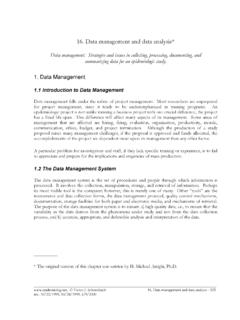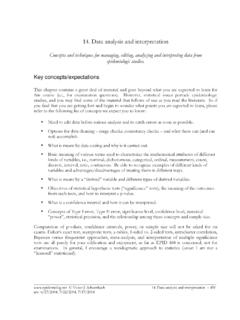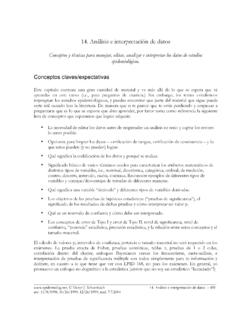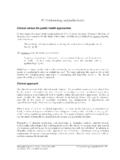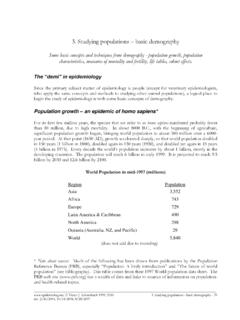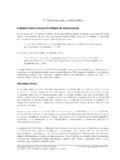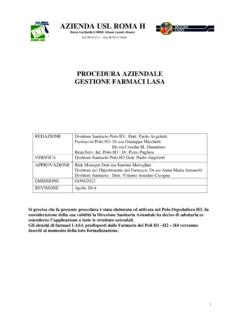Transcription of 11. Multicausality: Confounding
1 _____ , Victor J. Schoenbach 2000 11. multicausality : Confounding - 335 rev. 5/11/2001, 11/22/2003, 3/21/2004 11. multicausality : Confounding Accounting for the multicausal nature of disease secondary associations and their control Introduction When modern epidemiology developed in the 1970s, Olli Miettinen organized sources of bias into three major categories: selection bias, information bias, and Confounding bias. If our focus is the crude association between two factors, selection bias can lead us to observe an association that differs from that which exists in the population we believe we are studying (the target population). Similarly, information bias can cause the observed association to differ from what it actually is. Confounding differs from these other types of bias, however, because Confounding does not alter the crude association. Instead, concern for Confounding comes into play for the interpretation of the observed association.
2 We have already considered Confounding , without referring to it by that term, in the chapter on age standardization. The comparison of crude mortality rates can be misleading, not because the rates are biased, but because they are greatly affected by the age distributions in the groups being compared. Thus, in order to be able to interpret the comparison of mortality rates we needed to examine age-specific and age-standardized rates in order avoid or equalize the influence of age. Had we attemped to interpret the crude rates, our interpretation would have been confounded by age differences in the populations being compared. We therefore controlled for the effects of age in order to remove the Confounding . In this chapter we will delve into the mechanics of Confounding and review the repertoire of strategies to avoid or control it. Counterfactual reasoning Epidemiologic research, whether descriptive or analytic, etiologic or evaluative, generally seeks to make causal interpretations.
3 An association between two factors prompts the question what is responsible for it (or in the opposite case, what is responsible for our not seeing an association we expect). Causal reasoning about associations, even those not the focus of investigation, is part of the process of making sense out of data. So the ability to infer causal relationships from observed associations is a fundamental one. In an epidemiologists ideal world , we could infer causality by comparing a health outcome for a person exposed to a factor of interest to what the outcome would have been in the absence of exposure. A comparison of what would occur with exposure to what would occur in the absence of exposure is called counterfactual, because one side of the comparison is contrary to fact (see Rothman and Greenland, p49, who attribute this concept to Hume s work in the 18th century). This counterfactual comparison provides a sound logical basis for inferring causality, because the effect of the exposure can be isolated from the influence of other factors.
4 _____ , Victor J. Schoenbach 2000 11. multicausality : Confounding - 336 rev. 5/11/2001, 11/22/2003, 3/21/2004 In the factual world, however, we can never observe the identical situation twice, except perhaps for instant replay , which does not allow us to alter exposure status. The plethora of factors that can influence an outcome vary from person to person, place to place, and time to time. Variation in these factors is responsible for the variability in the outcomes we observe, and so a key objective in both experimental and observational research is to minimize all sources of variability other than the one whose effects are being observed. Only when all other sources of variability are adequately controlled can differences between outcomes with and without the exposure be definitively attributed to the exposure. Experimental sciences Experimental sciences minimize unwanted variability by controlling relevant factors through experimental design.
5 The opportunities for control that come from laboratory experimentation are one of the reasons for their power and success in obtaining repeatable findings. For example, laboratory experiments can use tissue cultures or laboratory animals of the same genetic strain and maintain identical temperature, lighting, handling, accommodation, food, and so forth. Since not all sources of variability can be controlled, experiments also employ control groups or conditions that reflect the influence of factors that the experimenter cannot control. Comparison of the experimental and control conditions enables the experimenter to control analytically the effects of these unwanted influences. Because they can manipulate the object of study, experiments can achieve a high level of assurance of the equivalence of the experimental and control conditions in regard to all influences other than the exposure of interest. The experimenter can make a before-after comparison by measuring the outcome before and after applying an exposure.
6 Where it is important to control for changes that occur with time (aging), a concurrent control group can be employed. With randomized assignment of the exposure, the probability of any difference between experimental and control groups can be estimated and made as small as desired by randomizing a large number of participants. If the exposure does not have lingering effects, a cross-over design can be used in which the exposure is applied to a random half of the participants and later to the other half. The before-after comparison controls for differences between groups, and the comparison across groups controls for changes that occur over time. If measurements can be carried out without knowledge of exposure status, then observer effects can be reduced as well. With sufficient control, a close approximation to the ideal, counterfactual comparison can be achieved. Comparison groups In epidemiology, before-after and cross-over studies are uncommon, partly because the exposure often cannot be manipulated by the investigator; partly because of the long time scale of the processes under study; and partly because either the exposure, the process of observation, or both often have lasting effects.
7 The more usual approximation to a counterfactual comparison uses a comparison group, often called a control group on analogy with the experimental model. The comparison group serves as a surrogate for the counterfactual exposed group without the exposure . Thus, the adequacy of a comparison group depends upon its ability to yield an accurate _____ , Victor J. Schoenbach 2000 11. multicausality : Confounding - 337 rev. 5/11/2001, 11/22/2003, 3/21/2004 estimate of what the outcomes would have been in the exposed group in the absence of the exposure. Randomized trials The epidemiologic study design that comes closest to the experimental model is the large randomized, controlled trial. However, the degree of control attainable with humans is considerably less than with cell cultures. For example, consider the Physicians Health Study, in which Dr. Charles Hennekins and colleagues at Harvard University enrolled physicians (including several faculty in my Department) into a trial to test whether aspirin and/or beta carotene reduce risk of acute myocardial infarction and/or cancer.
8 The study employed a factorial design in which the physicians were asked to take different pills on alternate days. One group of physicians alternated between aspirin and beta carotene; another group alternated between aspirin and a placebo designed to look like a beta carotene capsule; the third group alternated between an aspirin look-alike and beta carotene; and the fourth group alternated between the two placebos. In this way the researchers could examine the effects of each substance both by itself and with the other two separate experiments conducted simultaneously. With 20,000 participants, this study design ensured that the four groups were virtually identical in terms of baseline characteristics. But there was clearly less control over physicians during the follow-up period than would have been possible with, say, laboratory rats. For example, the physician-participants may have increased their exercise levels, changed their diets, taken up meditation, or made other changes that might affect their disease risk.
9 Such changes can render a study uninformative. The MRFIT debacle Just such an unfortunate situation apparently developed in the Multiple Risk Factor Intervention Trial (MRFIT), a large-scale (12,000 participants, over $100 million) study sponsored by the National Heart, Lung, and Blood Institute (NHLBI) of the National Institutes of Health (NIH). As evidence mounted that blood cholesterol was an etiologic risk factor for multiple forms of cardiovascular disease, particularly coronary heart disease (CHD), the possibility for a trial to verify that changing cholesterol levels would reduce CVD was being intensively explored. However, in the late 1960 s suitable drugs were not available; the only cholesterol-lowering intervention was dietary modification. A diet-heart trial would require over one million participants and last many years not an appealing scenario. The idea of a diet-heart trial persisted, however, eventually metamorphosizing into a study to verify that cardiovascular disease rates could be lowered by changing the three most common CVD risk factors: cigarette smoking, elevated serum cholesterol, and hypertension.
10 Thus was born MRFIT. The trial was launched in the early 1970 s. Men (because they have higher CHD rates) whose risk factors placed them at high CHD risk (based on a model from the Framingham Study) were randomized to Special Intervention (SI) or Usual Care (UC). SI participants received intensive, state-of-the-art, theoretically-based interventions to improve diet and promote smoking cessation. _____ , Victor J. Schoenbach 2000 11. multicausality : Confounding - 338 rev. 5/11/2001, 11/22/2003, 3/21/2004 Hypertensive SI participants were treated with a systematic protocol to control their blood pressure. UC participants had copies of their regular examinations sent to their personal physicians, but received no treatment through MRFIT. In this pre- wellness (health promotion / disease prevention through individual behavior change) era, the trial s designers projected modest risk factor changes in SI participants and little if any change in UC participants.
